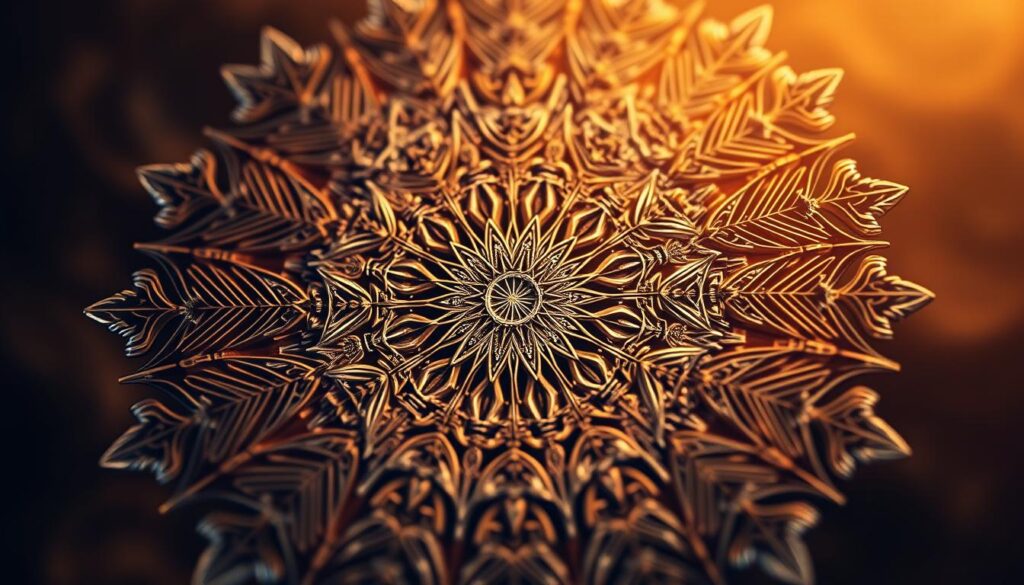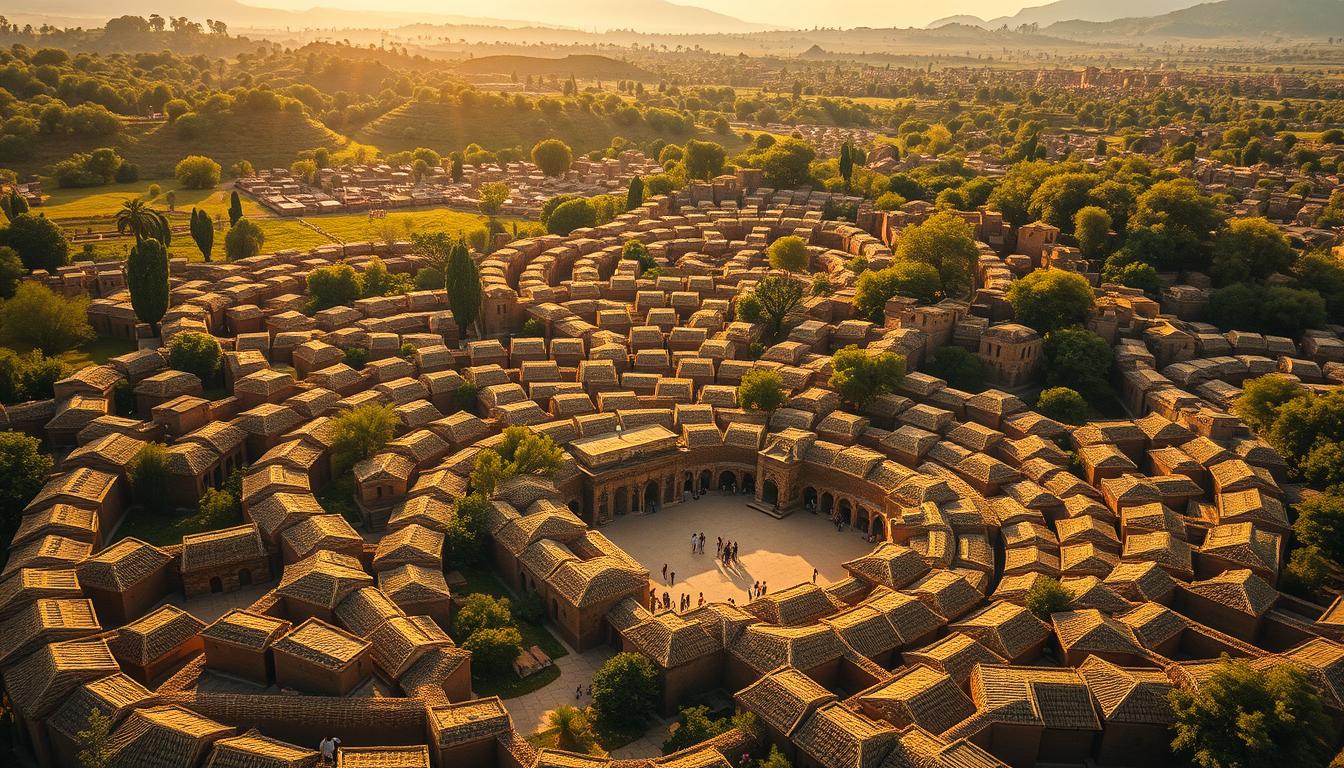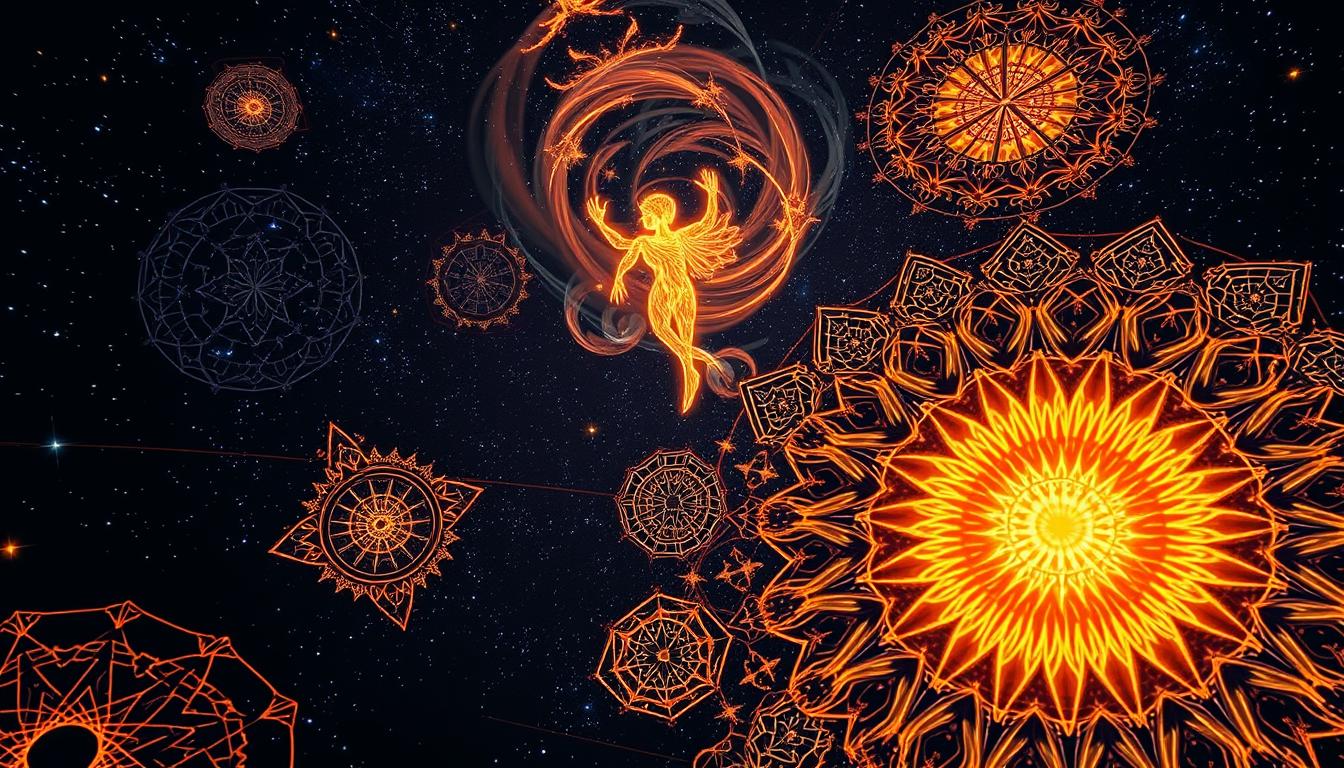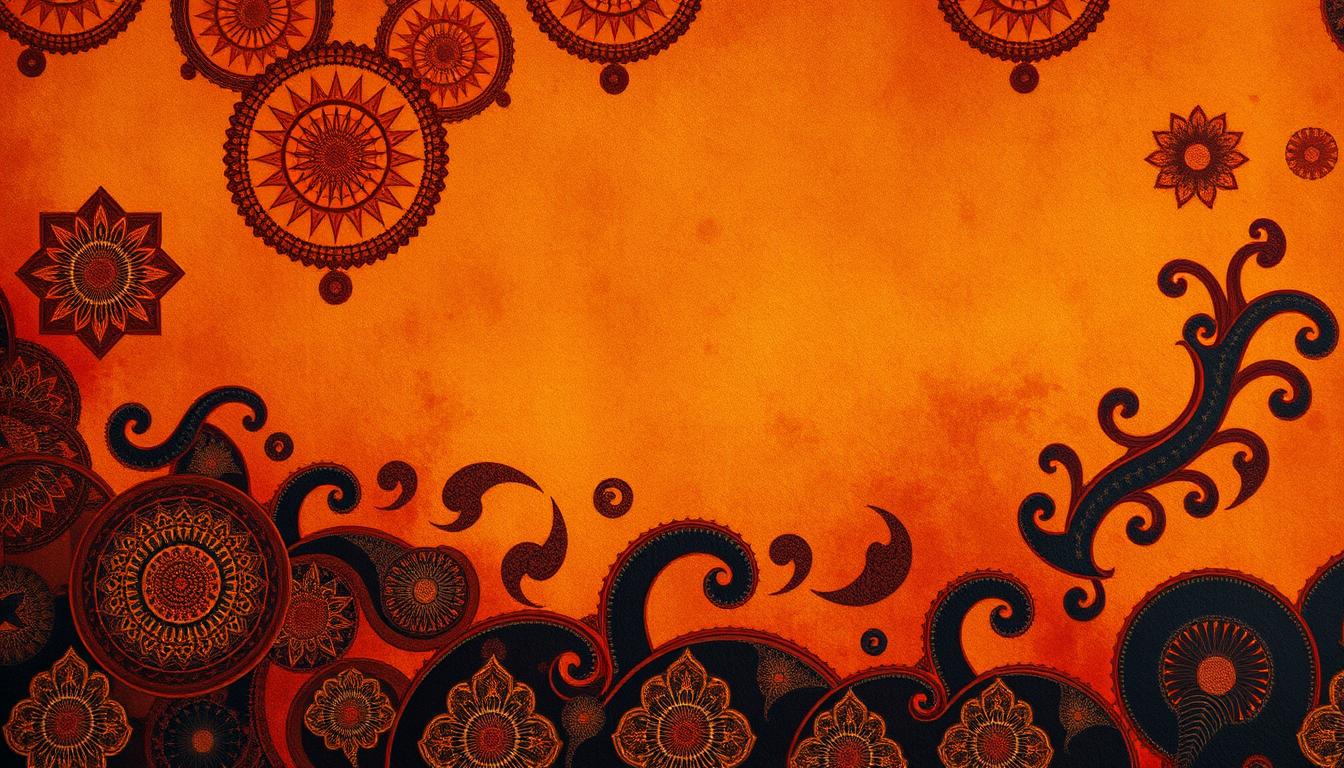Fractal symbolism adds depth to our grasp of indigenous ceremonies and rituals. It shows us how fractal patterns appear in cultural practices. This reveals the strong bond between art, architecture, and spirituality in indigenous groups.
We start with a general look at fractals. Then, we zoom in on indigenous rituals that use these colorful designs. This highlights their importance in community life.
Understanding Fractals: A Cultural Perspective
Fractals show complex patterns in math and nature. They include self-similar shapes seen in clouds and coastlines. They help us see the beauty and complexity of the world, connecting to cultural beliefs.
Defining Fractals and Their Importance
Fractal geometry explores intricate patterns in complex systems. Nature is full of fractals like trees and rivers. These patterns help us understand the connection between nature and culture, showing how everything is related.
Cultural Significance of Fractal Patterns
Indigenous cultures have used fractal patterns in art and buildings for centuries. They match these patterns with their traditions and beliefs. Ron Eglash’s studies show fractals are both beautiful and meaningful in these cultures. They blend math with cultural identity, showing life’s harmony in complexity.

Fractal Symbolism in Indigenous Ceremonies and Rituals
Indigenous ceremonies show how rituals and nature are connected. Fractal patterns are key in showing these links, demonstrating the close ties in life. These designs are not just for looks; they highlight nature’s cycles and connections.
Connections Between Nature and Spirituality
Indigenous beliefs are rooted in nature, viewing it as sacred. They celebrate natural cycles, like seasons and moon phases, in their rituals. These ceremonies use elements like water and fire, showing the fractal ties between all that lives.
Patterns in Rituals and Celebrations
In rituals and celebrations, fractals show life and nature’s cycles. Themes of growth and connection are common. These practices strengthen community ties, showing we’re part of something bigger. Through these ceremonies, people deepen their spiritual connection to the environment.
The Role of Architecture in Fractal Design
Fractal geometry is vital in indigenous architecture, shaping spaces and cultural identity. It shows how housing arrangements show deep social bonds and spiritual beliefs. Through fractal designs in buildings, a community’s values and environmental relations are clearly seen.
Fractal Arrangements in Indigenous Housing
Indigenous housing often uses fractal designs, showing interconnectedness and similarity. Designs may have concentric circles or spirals, symbolizing unity and continuity. These designs are found worldwide, reflecting a culture’s beliefs in their architecture. Notable features are:
- Concentric layouts that represent family lineage and communal ties.
- Circular designs that facilitate gathering and social interaction.
- Layered structures that enhance spatial harmony and environmental integration.
Fractal Elements in Community Layouts
Community designs often include fractal elements demonstrating collaboration and collective identity. These patterns create spaces for people to interact and share experiences. Characteristics of these designs are:
- Multipurpose areas that adapt to community needs.
- Designs that allow for a natural flow between communal and private spaces.
- Integration with the natural landscape, highlighting sustainability and respect for nature.
Fractals in Indigenous Art and Textiles
Indigenous textiles show the importance of culture in art. Their intricate designs tell deep stories. Using fractal patterns, artisans share stories and connections to their ancestors. Each piece is a display of skill. It represents the community’s culture and heritage.
Pattern Recursion in Textiles
Fractal patterns connect design and meaning in fabric. They often symbolize nature or spirituality, important to indigenous peoples. Artisans weave these designs with purpose. Their work resonates with cultural values and history.
The Intersection of Art and Spiritual Symbols
Art and spirituality blend in indigenous textiles. Each piece shows the cultural value of these textiles. It combines art with sacred symbols. Fractal designs repeat to highlight spiritual beliefs, adding depth to the textiles’ beauty.
Mathematical Concepts Behind Indigenous Designs
The blend of math in indigenous designs shows art’s link to cultural identity. African fractal designs show how geometry in African culture is more than beauty. It carries complex social meanings too.
African Influence on Fractals in Design
Fractal patterns are core to African art, showing its unique art impact. The repetition in fractals appears in art forms like textiles and sculptures. These patterns share social structures and nature, adding deep meaning to simple visuals.
Mathematics Meets Culture: An Overview
Math in culture is more than abstract. It tells the stories of people. In African culture, geometry shows in community designs and shows the importance of fractal theory. Studies say indigenous groups use math to share identity and history, telling lasting stories.
The Oral Traditions and Myths Reflecting Fractal Patterns
Oral traditions are key in keeping indigenous cultures alive. They hold wisdom and memories shared across generations. These stories often mirror fractals, showing recursion in folklore.
Through storytelling, communities share their beliefs, values, and life experiences. This creates a tapestry that shows how humans, nature, and the universe are connected.
Storytelling and Recursion in Indigenous Lore
In many cultures, stories are told in a way that brings them back around, similar to cycles. This makes the stories resonate with listeners, making them feel part of something bigger. Repetition not only emphasizes the message but also adds depth to the storytelling.
This method shows how fractals are part of oral history. Each time a story is told, it might reveal something new, but it sticks to its core cultural themes.
Myths as a Historical Record of Knowledge
Myths are like historical records that capture a culture’s view of the world. They contain lessons and knowledge, helping to educate and unite communities. As these stories are told, they stress the importance of remembering our past.
Through storytelling, myths do more than tell stories; they act like fractals of history. They hold a wide range of human experiences, showing how we fit into the natural and cosmic realms.
Fractals in Ritual Practices Across Cultures
Many cultures around the world use fractal patterns in their rituals. African rituals are especially known for their spiritual connections. These ceremonies showcase fractal designs that link to the natural world. They symbolize how everything is connected. These patterns help people feel closer to their culture and each other.
Examples from African Indigenous Groups
The Bamana priests of Mali use fractals to tell spiritual stories. This method combines math with spirituality in a unique way. Other groups in Africa also use fractals in their ceremonies. They emphasize nature’s recurring patterns and cycles through these designs.
Comparative Analysis with Native American Ceremonies
African rituals have a lot in common with Native American ceremonies. Both use fractals to build a sense of community and understand nature. Native American ceremonies often feature circles. These circles represent unity and the cycle of life, just like African fractals. This shows how cultures worldwide value nature’s intricate shapes.
The Psychological Impact of Fractal Symbolism
Fractals and psychology together offer deep insights. These patterns are key in many indigenous ceremonies, uniting people. They make people feel connected to their communities and increase their sense of belonging.
How Fractal Patterns Influence Community Consciousness
Fractals help people understand their culture deeply. By using patterns from nature and history, people feel proud of their roots. This pride builds emotional ties, making communities stronger and more active in cultural events.
Fractals in Ritual Psychology and Healing
Fractal patterns play a big role in ritual psychology. They’re used in healing ceremonies to show how everything is connected. These patterns create a soothing space, helping people go through healing and feel better.
The Adaptation of Fractal Symbolism in Contemporary Ceremonies
Today, indigenous ceremonies mix old values with new ways, focusing on fractal symbolism. This shows how cultural traditions grow but keep their core. Fractal designs in modern political events link our history with today’s world.
Modern Interpretations of Traditional Practices
Indigenous communities are creative, blending respect for ancestors with today’s lifestyle. Fractals act as a deep visual language, showing intricate ties in stories. This mix highlights the importance of keeping traditions that still speak to the youth.
How Fractal Designs Are being Incorporated Today
Fractal designs are now in art, fashion, and events, connecting the past with who we are today. This renaissance creates a strong sense of community and history. It shows a blend of pride and openness to change.
Global Perspectives on Indigenous Fractal Symbolism
Fractal symbolism spans across different cultures around the world. It shows how various societies understand fractal designs in their unique yet connected ways. This highlights the deep meanings and beliefs people have, linking humans across the globe.
Exploring Traditions Beyond North America
Indigenous fractal symbols are found in Africa, Australia, and Asia. Africa’s beadwork shows community ties. Australian Aboriginal art ties to the land through fractals. Asian tribes use spirals to tell their stories, reflecting their environments. These practices reveal the diverse cultural identities through fractals.
Common Threads in Global Indigenous Cultures
Looking at indigenous practices worldwide, some themes stand out. Life cycles, nature, and community bonds often appear in rituals and art. Fractal designs help us understand how different cultures see the world. This shows how fractal symbolism is a universal language, connecting different cultures.
The Intersection of Fractals and Digital Media
Fractals and digital media merge to protect and share indigenous knowledge. They transform traditional archiving, making it modern and accessible. This approach respects and amplifies indigenous voices for wider audiences.
Archiving Indigenous Knowledge with Fractal Designs
Fractals bring a new way to capture indigenous knowledge digitally. These patterns reflect the depth of cultural stories. They show the complexity traditional methods might miss.
Online Platforms for Sharing Cultural Heritage
Today, many websites help share indigenous cultures through digital fractals. These sites keep traditions alive and let communities connect with their heritage. Users can dive into historical contexts and understand indigenous cultures better through interactive fractals.
Conclusion
Fractal symbolism is deeply important in indigenous traditions around the world. These complex patterns show how everything in life is connected. They mix the beauty of nature with spiritual ideas.
Indigenous peoples use fractals to tell stories that everyone can relate to. These stories link people and the world around them.
Fractals remain important even as the world changes. They show who we are and where we come from. They also teach us how to keep traditions alive in today’s world.
Respecting and keeping these patterns alive is crucial. They are a key part of cultural heritage. We should honor and protect them.
Understanding fractals in indigenous ceremonies helps us appreciate their beauty. It shows us how they shape communities and spiritual life. By valuing them, we help keep these traditions alive for future generations.



